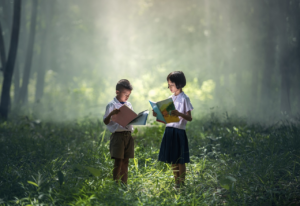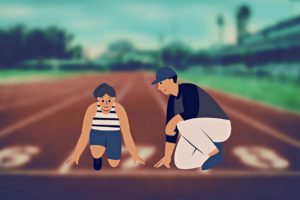Are you ready to embark on a literary journey through some of the most beloved children’s books by award-winning authors? From Eric Carle’s The Very Hungry Caterpillar to J.K. Rowling’s Harry Potter and the Philosopher’s Stone, these books have captured the hearts and imaginations of generations of readers.
In this article, we will explore the themes, characters, and writing styles of six classic children’s books written by some of the most renowned authors of our time.
You’ll discover the magic of Maurice Sendak’s Where the Wild Things Are, the heartwarming tale of friendship in E.B. White’s Charlotte’s Web, and the whimsical poetry of Shel Silverstein’s The Giving Tree.
So come along on this literary adventure and rediscover the joy of reading these timeless stories.
Key Takeaways
- Beloved children’s books such as The Very Hungry Caterpillar, Where the Wild Things Are, Charlotte’s Web, Harry Potter and the Philosopher’s Stone, and The Giving Tree have unique styles and messages that make them literary icons and a testament to the power of storytelling.
- Award-winning children’s books do an excellent job of guiding children through the process of moral development and providing a sense of hope and resilience in readers of all ages.
- The positive effects of selflessness on character development in young readers can’t be overstated and is encouraged through books such as The Giving Tree.
- The Lion, the Witch and the Wardrobe is a classic children’s book exploring the eternal battle between good and evil, courage, and redemption, and has a thought-provoking exploration of morality and consequences of actions, making it a timeless message of hope and faith that inspires resilience in readers of all ages.
The Very Hungry Caterpillar by Eric Carle
You’re gonna love The Very Hungry Caterpillar by Eric Carle – it’s a colorful and fun journey through the life cycle of a butterfly! Eric Carle’s artistic style is one-of-a-kind, and his creative process for bringing his stories to life is truly fascinating.
He uses a unique technique called ‘collage’, which involves cutting and layering different materials to create his illustrations. This creates a beautiful and textured visual experience for young readers, and really brings the story to life.
But The Very Hungry Caterpillar is more than just a pretty picture book. It’s had a significant impact on early childhood education, teaching children about the life cycle of a butterfly and the importance of healthy eating habits. With its simple language and bright illustrations, it’s become a staple in classrooms and homes around the world.
And with over 50 million copies sold, it’s no wonder why The Very Hungry Caterpillar is a beloved classic that has stood the test of time.
Where the Wild Things Are by Maurice Sendak
Maurice Sendak’s Where the Wild Things Are is a beloved classic that has captivated generations of readers with its imaginative storytelling and stunning illustrations.
This book takes readers on a journey through a young boy’s exploration of imagination as he ventures into a world of wild things. Through the protagonist’s journey, Sendak encourages readers to embrace their own imagination and let it run wild.
The symbolism in the illustrations adds another layer of depth to the story. The wild things represent the protagonist’s inner emotions and struggles, and the journey through the wild things’ kingdom is a metaphor for the protagonist’s journey through his own emotions.
The illustrations are beautifully detailed and add to the overall richness of the story.
Where the Wild Things Are is a must-read for anyone who wants to experience a truly imaginative and thought-provoking children’s book.
Charlotte’s Web by E.B. White
So, you’re about to dive into the world of Charlotte’s Web by E.B. White.
Get ready to be transported to a barnyard filled with themes of friendship and loyalty, as well as an exploration of life and death that will tug at your heartstrings.
This beloved children’s book has an enduring legacy that has touched the lives of generations, and you’re about to find out why.
The Book’s Themes of Friendship and Loyalty
If you’re looking for a story that’ll warm your heart and teach important lessons about friendship and loyalty, then Charlotte’s Web by E.B. White is a must-read.
The book explores the intricacies of these themes in children’s literature and examines their impact on young readers and society as a whole.
Through the unlikely friendship between a pig named Wilbur and a spider named Charlotte, the book teaches us about the importance of loyalty and the power of true friendship.
As you read this heartwarming tale, you’ll be swept away by the charming characters and their adventures. You’ll also learn about the true meaning of loyalty and how it can make a difference in our lives.
So, why not dive into this classic book and discover for yourself why it’s captured the hearts of readers for generations?
- The book teaches us about the value of true friendship.
- The unlikely friendship between a pig and a spider is heartwarming.
- The book is a timeless classic that’s captured the hearts of readers for generations.
The Book’s Exploration of Life and Death
As you delve deeper into Charlotte’s Web, you’ll come to realize that the book also touches on the delicate balance between life and death.
The story follows the friendship between a pig named Wilbur and a spider named Charlotte, who collaborates with other barn animals to save Wilbur from being slaughtered.
Along the way, the book explores the concept of grief and the different coping mechanisms people use to deal with loss.
One of the most poignant moments in the book is when Charlotte dies, leaving Wilbur to mourn her passing.
The author, E.B. White, portrays grief as a natural human emotion that everyone experiences at some point in their lives. He also shows how people can find solace in the memories and legacy of those who have passed on.
Overall, the book’s exploration of life and death is a powerful reminder of the fragility of life and the importance of cherishing the moments we have with the people and animals we love.
The Book’s Enduring Legacy
The enduring legacy of Charlotte’s Web is a testament to the timeless themes of friendship, love, and loss that continue to resonate with readers of all ages. The beloved classic by E.B. White has captured the hearts of generations since its publication in 1952 and has become a literary icon in its own right.
Exploring the book’s cultural impact, it’s clear that Charlotte’s Web has transcended its status as a children’s book to become a cultural touchstone that’s inspired countless adaptations, spin-offs, and even a theme park attraction. One of the key factors that make Charlotte’s Web such a beloved classic is its masterful use of symbolism.
From the spider’s web that spells out Wilbur’s fate to Charlotte’s own mortality, the book’s symbols are used to explore complex themes of life and death. By analyzing the book’s use of symbolism, readers are able to gain a deeper understanding of the story’s underlying messages and themes. Indeed, the enduring legacy of Charlotte’s Web is a testament to the power of great storytelling that speaks to readers of all ages and backgrounds.
Harry Potter and the Philosopher’s Stone by J.K. Rowling
Get ready to immerse yourself in the magical world of Harry Potter as you journey through the pages of J.K. Rowling’s award-winning novel, Harry Potter and the Philosopher’s Stone.
This book is not only a classic in children’s literature but also a literary phenomenon that has captured the hearts of readers worldwide. One of the reasons for its success is the analysis of character development that Rowling masterfully weaves into the story.
From the brave and curious protagonist, Harry Potter, to the mischievous and loyal Ron Weasley and the intelligent and resourceful Hermione Granger, each character grows and evolves throughout the novel, making them relatable and endearing to readers of all ages.
Another element that makes Harry Potter and the Philosopher’s Stone a beloved classic is its themes of magic and adventure. Rowling transports readers to a world where magic is real, and the impossible is possible, creating a sense of wonder and excitement that captivates readers.
The novel is filled with thrilling moments, from Harry’s first flight on a broomstick to his battle against the dark wizard, Voldemort. The story also explores themes of friendship, bravery, and self-discovery, making it a timeless tale that resonates with readers of all generations.
In short, Harry Potter and the Philosopher’s Stone is a literary journey that transports readers to a magical world filled with adventure, friendship, and wonder.
The Giving Tree by Shel Silverstein
As you delve into the world of Shel Silverstein’s The Giving Tree, you’ll discover themes of selflessness and generosity that will tug at your heartstrings.
This beloved children’s book explores the nature of human relationships and the sacrifices we make for those we love.
Decades after its original publication, The Giving Tree remains a timeless classic with enduring appeal that will resonate with readers of all ages.
The Book’s Themes of Selflessness and Generosity
Exploring award-winning children’s books takes readers on a heartwarming journey of selflessness and generosity woven into the themes. The Giving Tree by Shel Silverstein is a prime example of this, as it showcases the themes of altruism and kindness in children’s literature. The book’s message of giving without expecting anything in return teaches young readers the value of selflessness. It shows how even the smallest acts of kindness can have a profound impact on the people around us.
To evoke an emotional response in the audience, consider this table:
| Selfless Acts | Impact on Others |
|---|---|
| Sharing toys | Brings joy and happiness |
| Helping a friend | Builds trust and strengthens relationships |
| Donating to charity | Helps those in need and creates a better world |
The table highlights the positive effects of selflessness on character development in young readers. It encourages them to think about the ways they can make a difference in the world by showing kindness to others. The Giving Tree is a timeless classic that continues to inspire generations of readers to be kind and selfless, reminding us that the true meaning of life lies in giving to others.
The Book’s Exploration of Human Nature and Relationships
Immerse yourself in The Giving Tree’s exploration of human nature and relationships, as it delves into the intricacies of our connections with others and the sacrifices we make for those we love. This award-winning children’s book by Shel Silverstein is a timeless classic that continues to resonate with readers of all ages.
Through its poignant storytelling and beautiful illustrations, The Giving Tree offers a thought-provoking analysis of character relationships and an exploration of moral development. The book’s central theme revolves around the relationship between a boy and a tree, who give and take from each other throughout their lives.
The tree’s selflessness and generosity towards the boy are depicted as acts of pure love, as she willingly sacrifices her branches, trunk, and even her life to make him happy. However, as the boy grows older and becomes more selfish, the tree’s giving nature is challenged, and their relationship becomes more complex.
The book’s exploration of human nature and relationships ultimately highlights the importance of empathy, kindness, and appreciation for those who love us.
The Book’s Legacy and Enduring Appeal
Now that we’ve explored the book’s themes of human nature and relationships, it’s time to dive into its enduring legacy. This book has been beloved by generations of readers, and its impact on childhood development can’t be overstated.
As a child, reading this book can help you develop empathy, understanding, and a love of literature that can last a lifetime.
But the book’s influence doesn’t stop there. It’s inspired countless writers and artists, shaping the literary landscape for years to come. Its characters, stories, and messages continue to resonate with audiences of all ages, proving that great literature truly stands the test of time.
As you explore this book, keep in mind the ways it has shaped the world of children’s literature and the impact it can have on your own life and the lives of future generations of writers.
The book’s timeless message of love and acceptance, the way it encourages children to think critically about the world around them, its ability to spark imagination and creativity in young readers, the sense of wonder and magic it brings to the reader’s life, and the book’s potential to inspire empathy and compassion towards others are all reasons why its legacy and enduring appeal remain so strong.
The Lion, the Witch and the Wardrobe by C.S. Lewis
So, you’re ready to dive into the world of Narnia with The Lion, the Witch and the Wardrobe by C.S. Lewis.
This classic children’s book explores the eternal battle between good and evil, as well as themes of courage and redemption.
The book’s significant place in both children’s literature and Christian allegory makes it a must-read for anyone exploring the genre.
The Book’s Exploration of Good vs. Evil
You can delve into the intricate exploration of good versus evil in these award-winning children’s books by renowned authors. The concept of morality in children’s literature is prevalent, and these books use the battle between good and evil to teach young readers valuable life lessons.
The Lion, the Witch and the Wardrobe by C.S. Lewis is a prime example of this. The book’s exploration of good versus evil is not only entertaining but also thought-provoking, leaving readers to ponder the implications of their actions and the consequences of their choices.
The impact of good versus evil on young readers is immense. These books provide a safe space for children to explore the complexities of morality and the consequences of their actions in a fictional world. They learn about the importance of making the right choices and the effects of their decisions on others.
The exploration of good versus evil in children’s literature is a crucial aspect of their moral development, and these award-winning books do an excellent job of guiding children through this process.
The Book’s Themes of Courage and Redemption
The characters in these books exemplify bravery and the power of redemption, inspiring readers to face their fears and strive for personal growth. Exploring the themes of courage and redemption in children’s literature allows readers to analyze character development and plot arcs, showcasing the transformative power of confronting challenges and persevering through adversity.
Through the stories of characters who have faced their fears and overcome obstacles, young readers are able to understand the importance of moral values and personal growth. The impact of these themes on children’s literature is immeasurable, as they instill a sense of hope and resilience in readers of all ages.
Whether it’s a young protagonist who must confront a bully or a group of friends who band together to save their community, the themes of courage and redemption showcase the best of humanity and inspire readers to become their own heroes.
The Book’s Significance in Children’s Literature and Christian Allegory
As a reader, you’ll appreciate how this book has become a significant example of Christian allegory in children’s literature. The book’s religious significance is evident in the way it explores themes of redemption, forgiveness, and sacrifice through the eyes of a young protagonist.
The book is widely regarded as a masterpiece of children’s literature, and its enduring popularity can be attributed to its timeless message of hope and faith. Symbolism and metaphors used in the book are also worth noting.
The book’s plot is layered with various religious symbols and metaphors that help to convey its central message. For example, the protagonist’s journey is reminiscent of Christ’s journey to the cross, and the use of darkness and light to represent good and evil is a common allegory in Christian literature.
Overall, this book is a must-read for anyone interested in exploring the use of Christian symbolism in children’s literature.
Frequently Asked Questions
What other books has Eric Carle written besides The Very Hungry Caterpillar?
You may be surprised to learn that Eric Carle, the author and illustrator of The Very Hungry Caterpillar, has written many other beloved children’s books.
Some of his other works include The Grouchy Ladybug, Brown Bear, Brown Bear, What Do You See?, and The Mixed-Up Chameleon.
Carle’s books are known for their colorful and imaginative illustrations and their ability to engage young readers.
As a celebrated author and illustrator of children’s books, Carle’s works have been recognized with many awards and accolades.
His contributions to the world of children’s literature make him a standout among other award-winning authors and illustrators.
How did Maurice Sendak come up with the concept of the Wild Things in Where the Wild Things Are?
To answer your question about Maurice Sendak’s creative process and the inspiration behind the Wild Things in his book Where the Wild Things Are, it all started from his own childhood experiences.
Sendak recalled feeling angry and frustrated as a child and often fantasized about running away to a place where he could be in charge. This idea eventually led him to create the Wild Things, who are fierce and unpredictable creatures that Max, the main character, encounters on his journey.
Sendak’s illustrations of the Wild Things were also inspired by monsters from his childhood, such as the Yiddish folk tales his parents told him.
Overall, Maurice Sendak’s creative process was deeply rooted in his own personal experiences and childhood memories, which allowed him to create a timeless classic that continues to captivate readers of all ages.
What inspired E.B. White to write Charlotte’s Web?
To understand E.B. White’s inspiration behind Charlotte’s Web, you have to dive into his writing process.
Unlike Maurice Sendak’s concept with Wild Things or J.K. Rowling’s idea with Harry Potter, White drew inspiration from real-life animal characters. As a child, he had a love for animals and grew up on a farm, which influenced his writing.
He wanted to create a children’s literature book that wouldn’t only entertain but also educate. White drew from Eric Carle’s books and Shel Silverstein’s other books to create a unique story that would stand out. His writing process was meticulous, and he spent a lot of time researching and studying the habits of spiders.
In the end, Charlotte’s Web became a classic, and White’s inspiration for the book has become a celebrated part of children’s literature history.
How did J.K. Rowling come up with the idea for the Harry Potter series?
You’re probably wondering how J.K. Rowling came up with the idea for her beloved Harry Potter series.
Well, the inspiration behind the series came to her on a delayed train ride from Manchester to London. She had been working as a teacher and struggling financially, but she suddenly had the idea of a boy who discovers he’s a wizard and attends a school for magic.
From there, she spent years developing the world of Hogwarts and its characters, even drawing on her own experiences with loss and loneliness. Her creative process involved filling notebooks with ideas and plotting out the entire series before even writing the first book.
It’s clear that her dedication and creativity paid off, as the Harry Potter series has become a cultural phenomenon beloved by millions.
What other famous books has Shel Silverstein written besides The Giving Tree?
You may be surprised to learn that Shel Silverstein, the beloved children’s author, has written several other famous works besides The Giving Tree. In fact, he has penned many popular titles, including Where the Sidewalk Ends, A Light in the Attic, and Falling Up.
These books have been cherished by generations of children for their whimsical humor, clever wordplay, and imaginative illustrations. Silverstein’s writing style is unique, but it shares some similarities with the enduring popularity of Eric Carle’s picture books, which also use vibrant visuals and simple language to capture the hearts of young readers.
Whether you’re a lifelong fan of Silverstein’s work or discovering it for the first time, his books are sure to bring joy and inspiration to all who read them.
Conclusion
Congratulations! You’ve just completed a literary journey through some of the most beloved children’s books by award-winning authors.
From Eric Carle’s classic tale of The Very Hungry Caterpillar to C.S. Lewis’ magical world of Narnia in The Lion, the Witch and the Wardrobe, you’ve explored stories that have captured the hearts and imaginations of generations of readers.
Each of these books offers something unique to both children and adults alike. Maurice Sendak’s Where the Wild Things Are takes us on a wild adventure through a child’s imagination, while E.B. White’s Charlotte’s Web teaches us about the value of friendship and sacrifice.
J.K. Rowling’s Harry Potter and the Philosopher’s Stone introduces us to a world of magic and wonder, and Shel Silverstein’s The Giving Tree reminds us of the importance of giving and love.
Whether you’re a parent looking to introduce your child to the joys of reading or simply want to revisit some childhood favorites, these books are sure to delight and inspire.
So sit back, relax, and let these award-winning authors take you on a literary journey that you’ll never forget.

















